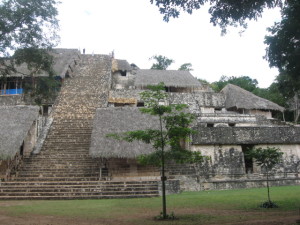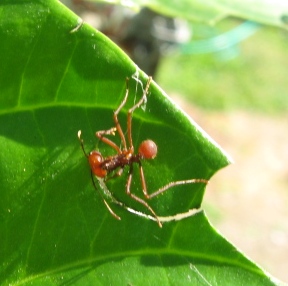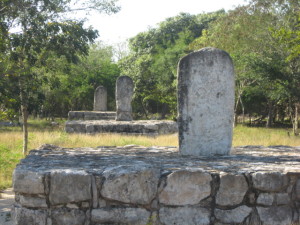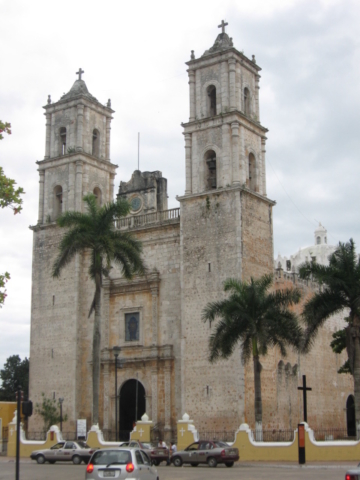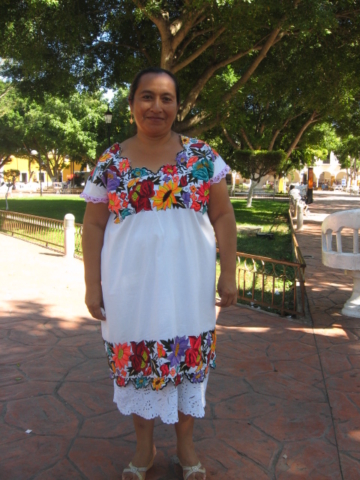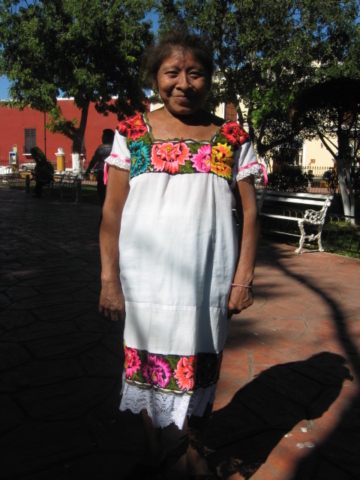
Ruta Maya – Part Five
This is part five of a series of articles about the Aztec and Mayan pyramids and ruins in Central America. Updated Sep 2022.
Ek Balam

Still based in Valladolid, we travelled north to the Mayan ruins of Ek Balam. The area is not extensive; there is one large pyramid, three other main structures, and some smaller ones. The pyramid is very different from all the others I have seen in that it is not triangular-shaped. Instead, it branches in all directions on many levels, like a condominium complex.
I could not get a decent photo of it for several reasons. First, it is too large to fit in a photo (unless you have a wide-angle lens, which I did not have at the time). The pyramid is only 30 metres tall, but it is an incredible 160 metres long. You cannot step back far enough to get more in the photo because you would be in the forest. Another reason is that the pyramid is undergoing restoration and is covered with construction materials and tarps. (UPDATE: This was in 2015. Hopefully, the repairs are now complete and the construction material removed.) However, I did get a nice photo of the other buildings and the surrounding forest from the top of the pyramid.
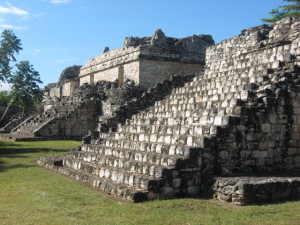
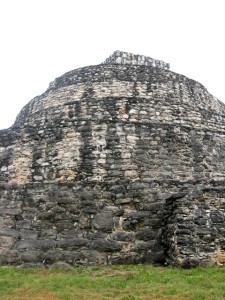
Ek Balam has a rare, round building. Almost all ancient structures have square corners.
The city had a wall around it, but now the wall is only about one metre in height.
Ek Balam was discovered only 30 years ago, and there are still many unexcavated structures that look like big piles of dirt and rocks.
Watch for Army Ants
I usually walk off the path into the forest a little to search for birds and wildlife. I didn’t see any new birds here, but we found some interesting ants. We noticed army ants on the march. They were marching in a column, about 2.5 cm wide (one inch). It extended for more than ten metres, and I could not find the destination or source because of the bushes. When hunting, they spread out and cover an area of about one metre. This is how we saw them last time. I find them very interesting.
Leaf-cutter Ants
We also found some leaf-cutter ants. I had seen this type of ant on television and hoped to find them here. These ants cut a piece of leaf off of a plant and carry it to their home. They made a path cleared of all leaves, sticks, and other debris. The trail was about 5 cm (2 inches) wide and extended as far as we could see into the bushes.
The ants were going out in one direction and returning with a leaf. They often carry a piece of leaf larger than their own body. This is like a person carrying a mattress for a queen-sized bed on their back in the vertical position and doing so for several kilometres. We saw a couple of overzealous ants that had taken a piece of leaf that was too much for them. They were staggering and falling from the weight. But they never gave up and were making good progress nevertheless. They don’t eat the leaves. Instead, they store them underground and feed them to a fungus. The fungus eats the leaves, and the ants eat the fungus. Like the army ants, I find the leaf-cutter ants very interesting.
More information about Leaf-cutter ants and the ant highway can be found here.
Information about Army Ants.
What happens when Army Ants get lost? Find out at Lost Army Ants.
Dzibilchaltun
North of Ek Balam, near the coast, is the Mayan site of Dzibilchaltun (Pronounced dizzy-bil-chal-tun).
Dzibilchaltun was in use from about 500 BC until the arrival of the Spanish in the 1540s, making it one of the longest continuously inhabited Mayan sites. The only structure that is in good condition is the temple. There is a small pyramid that once had a wooden temple on it, but the temple has long since disappeared.
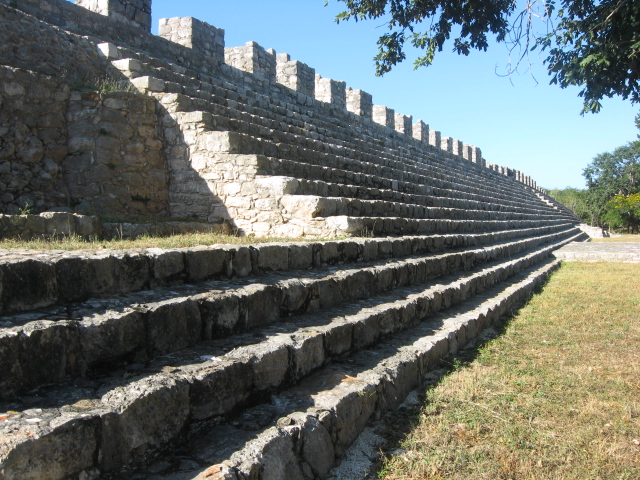
There are four platforms with large vertical stones on them. These stones once had carvings or paintings, but they have been worn smooth over the centuries.
One building facing the town plaza has the widest stairway of any Mayan ruins. Unfortunately, not much else remains of the building except the stairs.
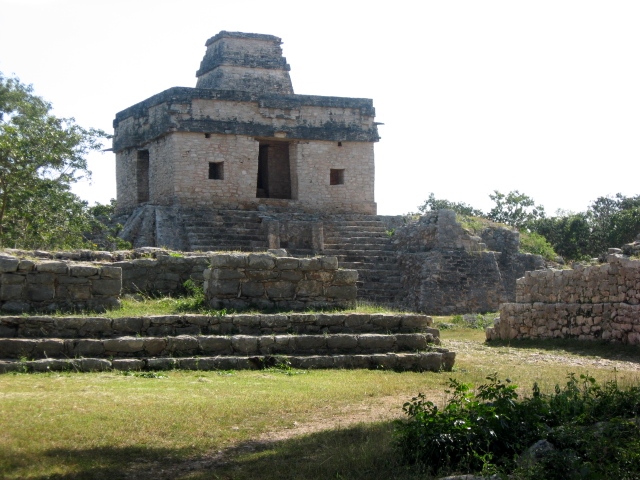
When the Spanish arrived, they used stones from the Mayan structures to build a Catholic church and a house for the priest right in the middle of the town square.
Getting to Dzilbilchaltun
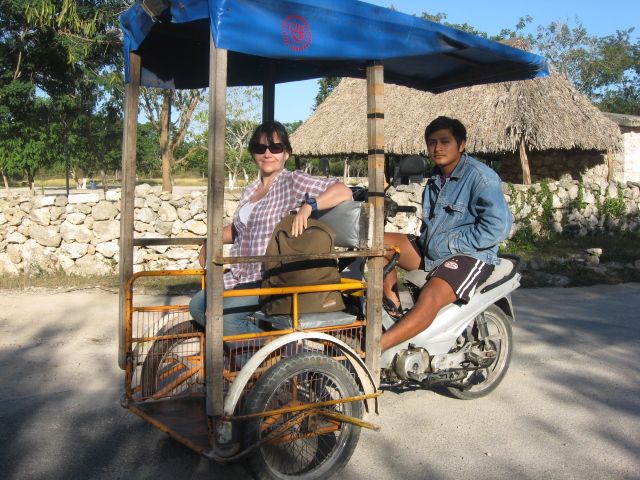
To get to the ruins, we took a bus to a nearby village, and from there we went by motorcycle taxi. This vehicle has the back end of a motorcycle with a large box on the front that can carry two passengers. It felt strange to be zipping down the road with absolutely nothing in front of us. There was no door, no seat belts, nothing. Fortunately, we only had to travel a few kilometres in it.
I go to these archaeological sites not only to see the ruins but because they are also great places to see birds. In addition to the ruins, there is a path through the forest where many kinds of birds can be seen. For example, I saw Altamira Orioles and Turquoise-browned Motmots. Both are gorgeous birds.
Ek Balam and Dzilbilchaltun are not as impressive as Chichen Itza and other large Mayan sites, but they have some fascinating and unique structures. Try to include them in your tour of the Ruta Maya if you have time.
Valladolid
For three daily trips to the ruins of Chichen Itza, El Balam and Dzibilchitun, we were based in the city of Valladolid. Before proceeding to the next stop on the Ruta Maya, we spent a day touring this interesting city. There is a lovely church and fascinating little shops, but the people are the main thing to study in Valladolid. When I talk to people about the Ruta Maya, they often ask me why the Mayan people disappeared. My answer surprises them. The Maya did not disappear and are still living in the area. They abandoned their fabulous cities because of overcrowding, warfare, and other reasons, some of which are unknown. But they did not disappear off the planet. Instead, they took up life in little villages in the jungle. One of those villages is now the city of Valladolid.
Many women still wear traditional pretty Mayan dresses, primarily white, with multi-coloured bands across the top and bottom. However, this will probably be the Maya’s last generation of women to wear these traditional clothes as most of the younger women are now wearing blue jeans.
Please note that the women in these photos willingly posed for photos. If you ask nicely, some will pose for you. Do not take photos of the Mayan people without asking permission.
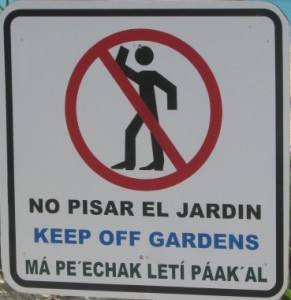
The Mayan language is still spoken in the area, and signs at tourist attractions are in Spanish, English and Mayan.
Part Six
The next stop on the Ruta Maya is the fabulous city of Uxmal. It is one of Ruta Maya’s highlights, along with Chichen Itza and Tikal. Click here.
Other stops on Ruta Maya
If you missed the articles on part one to four click here:
